This is the first part of a series about symmetry in origami. Here I will explain what a symmetry group is through a series of examples.

This image is sourced from a video with folding instructions.
This heart illustrates one of the most basic forms of symmetry. A symmetry is a transformation that preserves the shape and orientation of the object. In this case, the transformation is a reflection. If you reflect the heart across a vertical line, you get back the same heart. But with further examples, we can see that this is not the only kind of symmetry.
This ninja star has rotational symmetry. If you rotate the star 90 degrees clockwise, you get back the same star (ignoring color, which we’ll get to later). You can also rotate the star 180 degrees clockwise, or 270 degrees clockwise.
Here’s an existential question. Suppose that an object has 90 degree rotational symmetry. Must it also have 180 degree rotational symmetry? Well, if you rotate the object 90 degrees, you get back the same shape, and the shape still has the same symmetry. So if you rotate it by 90 degrees again, then you’ll get back the same shape again. Therefore, the object must have 180 degree rotational symmetry.
What this demonstrates is that you can’t just pick and choose your symmetries without constraint. Only certain sets of symmetries are allowed. An allowable set of symmetries is known as a symmetry group. A symmetry group is an example of what is known in mathematics as a group. A group is a set of things which can be “multiplied” together. For instance, if you take a 90 degree rotation and “multiply” by itself, then you get a 180 degree rotation. We can define a group by writing out its multiplication table.
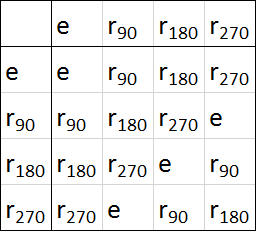
This is a multiplication table for the symmetry group of the ninja star. “rn” denotes rotation by n degrees. “e” denotes the identity transformation, or rotation by 0 degrees.
The multiplication table needs to obey a number of mathematical rules, which I won’t exhaustively describe. However, I note that every symmetry group must include the identity transformation, which is the transformation where you do nothing at all. Clearly no matter what shape you have, if you apply the identity transformation you will get the same shape back.
The order of a symmetry group refers to the number of elements in the group. The ninja star has a symmetry group of order 4.
Before we move on to 3-dimensional shapes, let’s discuss one last flat example: an unfolded square of paper.
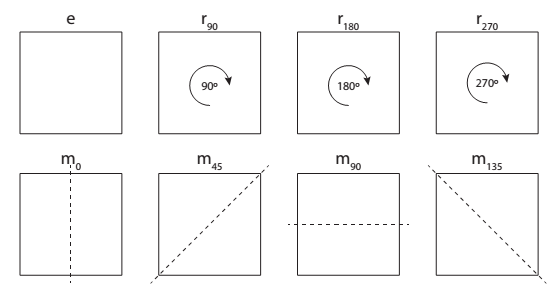
These are the 8 symmetries of a square. The top row shows the four rotations, including rotation by 0 degrees. The bottom row shows the four reflections. I’ve given arbitrary labels for each of the 8 symmetries.
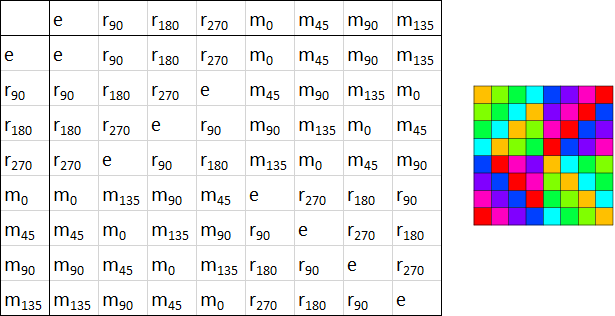
Here’s the multiplication table for the symmetry group of a square. On the right is the same multiplication table represented in a more compact and colorful way. The color table comes from Wolfram MathWorld.
The square has 8 symmetries, including 4 rotations and 4 reflections. We can still write out a multiplication table, but at this point it gets quite large and cumbersome. I don’t know about you, but I’m not getting anything out of the multiplication table, it’s just a bunch of noise to me. I’ll try to avoid showing tables from this point forward.
But I would like to point out one important fact about this multiplication table. The order in which you apply the tranformations makes a difference! The convention is that when you multiply a*b, that represents the transformation where you first apply b, followed by a. In general, a*b does not necessarily equal b*a. We can show that m0*r90 = m135, while r90*m0 = m45.
I have one last example for this post, which is the symmetry of a cube. If we only count rotations, and not reflections, then the symmetry group of a cube has order 24. I can show this by drawing a dot on one of the faces of the cube, and showing where that dot ends up when we apply each of the 24 rotations.
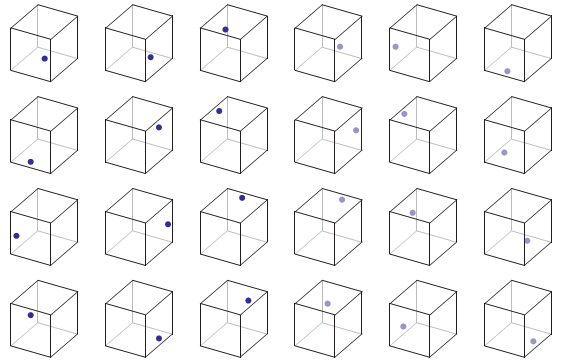
Suppose a draw a blue dot on one of the faces of the cube. For each of the 24 rotations, that dot will end up in a different place on the cube. For the right half of this diagram, the blue dot is shown in a lighter color to indicate that it is on one of the obscured faces on the back of the cube.
If we include reflections, then the cube’s symmetry group has order 48, but we won’t draw that.
There’s a lot more to talk about, but this is a convenient break point. As an exercise, try to figure out the order of the following symmetry groups:
1. Regular pentagon (rotations and reflections)
2. Tetrahedron (rotations only)
3. Tetrahedron (rotations and reflections)
4. Octahedron (rotations only)
5. Icosahedron (rotations only)

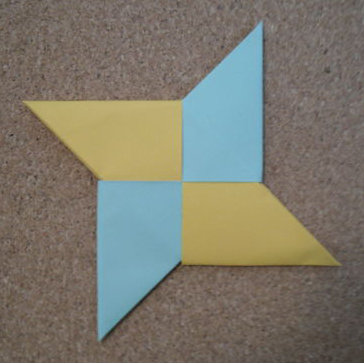
I love the symmetry of the heart. There’s something about the shape of an origami heart that I find particularly lovely. I haven’t folded one in a long time. Makes me want to fold one.